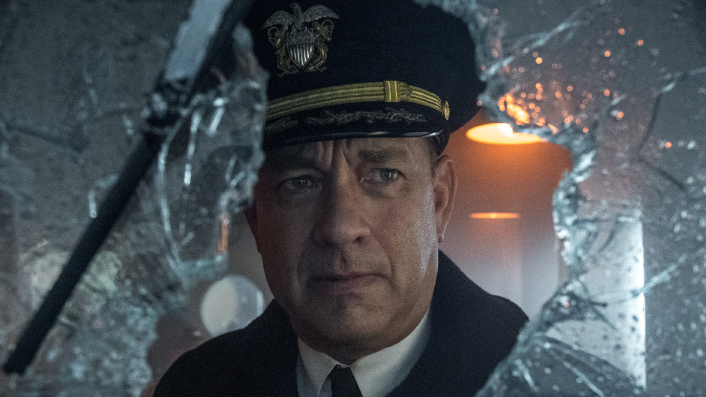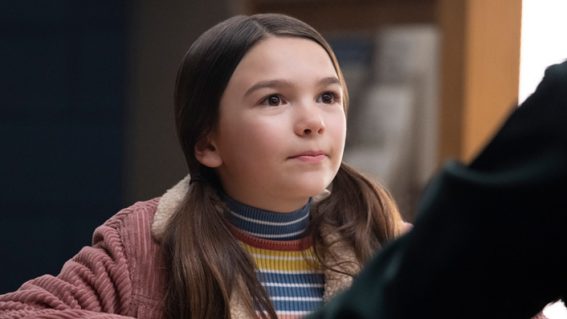Tom Hanks is the WWII captain now in Greyhound

Streaming on Apple TV+ from July 10, Tom Hanks writes, produces and stars (as fictional US naval commander Krause) in this WWII drama, escorting an international convoy across the North Atlantic while being hotly pursued by German U-boats. As Steve Newall writes, it’s Hanks and Hanks alone that earns the film a 3-star rating.
Screenwriter Tom Hanks (the charming That Thing You Do!, the blander Larry Crowne) embarks on his third feature as a writer with World War II naval drama Greyhound. Fortunately for the film, Hanks also takes the lead role, his performance elevating what otherwise likely could have been a dull endeavour. A decade on from his debut Get Low—a likeable ensemble piece with Robert Duvall, Sissy Spacek, Bill Murray etc.—Aaron Schneider is assigned directorial duties, leaving Hanks free to imbue fictitious naval commander Ernest Krause with lashings of gravitas.
Read more
* All new streaming movies & series
* The best shows and movies to stream this week
* New to Aotearoa streaming services in July
In command of the destroyer USS Keeling, codenamed Greyhound, Krause’s mission is to cross the North Atlantic, protecting a convoy of merchant ships en route to aid the war effort. Hanks sketches in some backstory for Krause (a love back home, a belief in the Almighty) but over the course of an economical 91 minutes, the film wastes little time in getting to the hairiest part of the mission—the period throughout which the convoy has no air cover and finds itself hounded by a pack of German U-boats, who seem to love tormenting the convoy with baying radio taunts just as much as they do blowing shit up.
This would be a dangerous enough proposition even if not for other complicating factors. As the hours tick by and the German submarines make their attacks, Krause grows fatigued—always on his feet, turning down meals, reliant on coffee—and begins to make mistakes. Duped into punching at shadows, he overcommits his munitions, going on to find himself in command of a convoy protector now dangerously low on anti-sub depth charges. And, as the the tiredness and stress compound, he misidentifies crewmembers—calling one named Fippler “Flipper” and, yikes, confusing two black galley stewards (the only men of colour on board… whose job it is to bring him meals) with one another. Painted as minor blips, the latter errors come across as the result of stress, while the former is a much graver strategic blunder. Both see Krause’s standing begin to diminish in the eyes of some of his crew.
Along with the weight of casualties on Krause—Krauts included—these are essential humanising elements to accompany the barking of naval jargon from the bridge, which makes up much of the film’s dialogue. The sonar operator reports blips on the screen; torpedo trajectories are yelled out with urgency; and Krause issues new bearings, orders to fire, and commands evasive action with his big steel beast of a ship. Schneider stages some effective action sequences, especially when the Keeling finds itself in too-close proximity to U-boats (and even friendly vessels), working well in tandem with Hanks to sell the tension.
Unfortunately, what makes some scenes in the film work so well, the somewhat claustrophobic confines of the Keeling’s bridge, becomes increasingly familiar, and Schneider’s work outside it is somewhat split between concisely framing the skirmishes and looking, well, a bit cheap for a $50 million dollar movie. Despite premiering on Apple TV+, Greyhound was intended for theatrical release, but definitely plays more like a made-for-streaming effort than a mid-priced studio pic, and it’s Hanks and Hanks alone that earns the film a 3-star rating.
Still, the naval engagements have their nerve-wracking moments, and Hanks the writer knows just how much he’s able to convey with his acting, taking some of the weight off his screenplay (though its not entirely free from hokeyness, it must be said). Pleasantly old-fashioned, Greyhound should thrill military enthusiasts, and Hanks does enough that the film should keep most viewers engaged throughout.

















